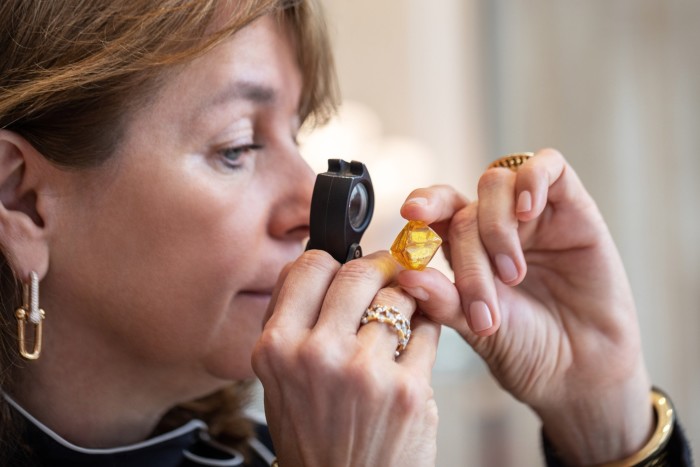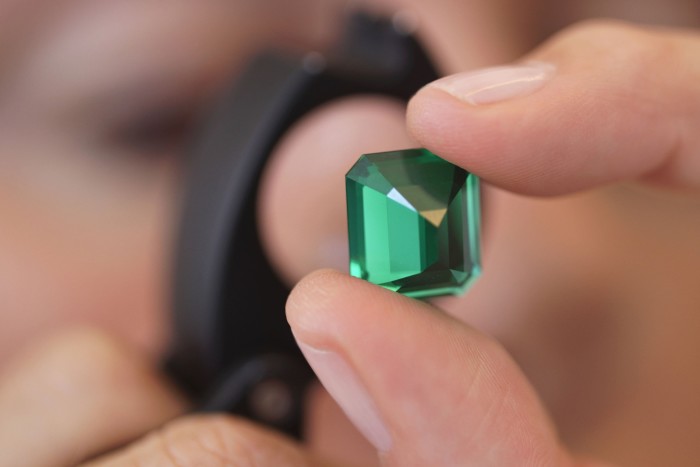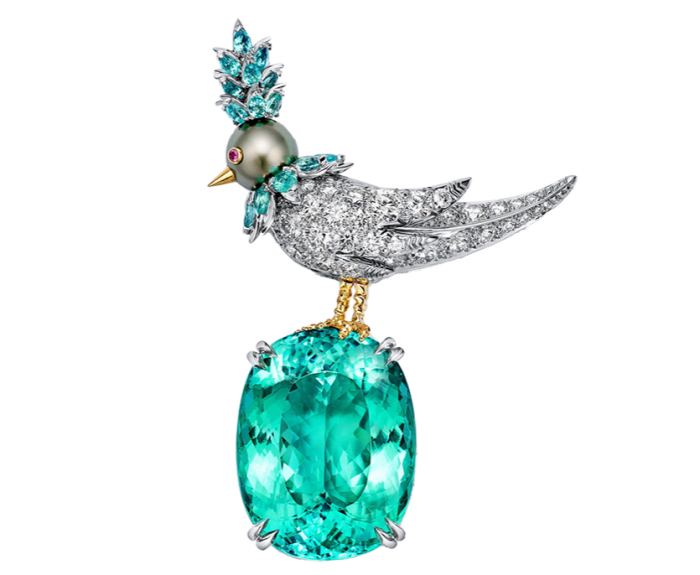Stone rarities show scale of Tiffany’s newfound ambition

Roula Khalaf, Editor of the FT, selects her favourite stories in this weekly newsletter.
When LVMH bought Tiffany & Co two years ago for $15.8bn, the luxury conglomerate wasted no time digging into its deep pockets to elevate the brand’s high jewellery proposition.
Tiffany’s two major gem acquisitions announced today — a miraculous rough yellow diamond and a magnificent cut-and-polished Colombian emerald, both extreme rarities and reckoned to be the best of their species in the world — indicate the scale of ambition that the world’s biggest luxury group has for the American jeweller, which is best known to many for silver jewellery and traditional engagement rings.
The spectacular 71.26-carat fancy vivid yellow rough diamond, of extraordinarily intense, highly saturated honey-gold colour, and a near-perfect octahedral shape, was recovered in August 2022 from the Ekati mine in Canada and later purchased at auction on behalf of Tiffany. Labelled a “super-stone” for the rarity of its quality, colour, crystal formation and size, it is the largest fancy vivid yellow diamond recovered in Canada.
The stone is being cut and polished in Antwerp, where the octahedral rough crystal was laser-cleaved into two pyramidal sections, each expected to yield an exceptional emerald-cut vivid yellow diamond of between 10 and 20 carats. The radiant golden hue is so rich and viscous that it edges towards orange, while the growth marks, including the tiny triangular “trigons” etched into the skin — like sacred geometry — add to the fascination.
“It’s humbling to see what nature creates,” says Victoria Reynolds, Tiffany’s chief gemologist. “As if primal sunlight is captured inside. It’s so rare to find such a perfect crystal, especially of this size and colour; the earth usually shakes up the diamond rough.”


Tiffany’s second acquisition is the nearly 11-carat rectangular-cut Muzo emerald. It is exceptional not only for its colour — a hypnotic, sunlit verdant green — but also for its extraordinary clarity: the stone has no fissures whatsoever and only microscopic inclusions that are characteristic of stones from the Colombian Muzo mine (named after the indigenous tribe that lived there before the Spanish arrived in the 16th century).
The stone was fashioned from a 293-carat rough crystal recovered in 2019 from the Puerto Arturo shaft of the Muzo mine, source of the best material. When the stone was offered to it, as part of a longstanding relationship with the mine, Tiffany seized the opportunity.
“It’s not a new thing,” says Tiffany president and chief executive Anthony Ledru of sourcing high-profile stones and the company’s heritage of gemstone discoveries. “[Founder] Charles Lewis Tiffany had the mindset of finding the finest gemstones in the world, for the most demanding clients in the world. To create astonishment. To see what’s never been seen, do what’s never been done. No price tag. Arctic diamonds are especially beautiful, and the Muzo emerald is the finest stone with the finest provenance. It’s all in Tiffany’s DNA.”
For Reynolds, too, both the emerald and the yellow diamond help Tiffany promote its gemstone legacy and its tradition of bringing historic, royal gemstones first to the US, then the world. She also refers to George Frederick Kunz, Tiffany’s first chief gemologist, as “the founding father of American luxury”. The yellow diamond has echoes of the celebrated 128-carat Tiffany Diamond, an enduring Tiffany emblem, which was also a new discovery, in South Africa, in 1877.
Reynolds also cites the Tiffany emerald necklace, exhibited at the company’s Vision & Virtuosity exhibition last year in London, set with Colombian emeralds believed to have belonged to Queen Isabella II of Spain, and the 75-carat Hooker emerald, brought to Europe by conquistadors, sold to an Ottoman sultan, acquired by Kunz for Tiffany in 1911, and now in the Smithsonian Institution’s collection in Washington DC.
This autumn, the Tiffany Muzo emerald will be shown as a loose stone to highlight its purity and allow the client to commission a bespoke jewel. The finished diamonds are destined for a Blue Book high-jewellery collection, and very likely for a design by Jean Schlumberger, the French high-society artist-jeweller, taken on by Tiffany’s then chair Walter Hoving in 1956 as the company’s first named designer. Schlumberger’s timelessly modern creations, reimagined today by Tiffany’s creative director, Nathalie Verdeille, are now the centrepiece of Tiffany’s high jewellery collections.
Ledru regards Schlumberger as “the driving force that defined the style of high jewellery in 20th century America”. He is particularly fond of Schlumberger’s iconic and charmingly irreverent Bird on a Rock, a design that has recently taken flight again, breeding fresh iterations, including a new setting for the Tiffany diamond to celebrate the revamp of its Fifth Avenue Landmark flagship store this spring.

Days before the flagship New York store reopened, LVMH also announced the acquisition of a majority stake in the Platinum Invest group, which operates jewellery workshops in France. Ledru says that the deal, for an undisclosed sum, gives Tiffany the resources to excel at high jewellery by employing “superstar artisans”. Platinum Invest’s jewellers will continue to do work for other luxury brands outside LVMH.
Ledru’s objective is to restore the “aesthetic excitement” that has been so much part of Tiffany’s quest throughout its 186-year history. “We have the opportunity to write amazing new pages in the Tiffany story, and the ability to take it to the next level,” he says.
This article has been updated since original publication to clarify the location of the yellow diamond cutting.
Comments